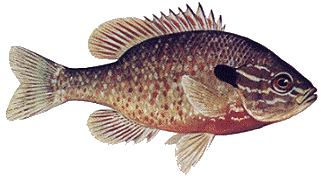I want to go on record as being a devoted bluegill fisherman. That
doesn't mean I fish only for bluegill, because I pursue many species of fish,
but it does mean I rank bluegill near the top of the list of things I like to
do most.
Bluegill fishing is exciting, it can be extremely challenging, and there is
nearly always plenty of action. I've spent much time fishing for many game fish
species, and I've enjoyed every hour I've spent on the water, but some of my most
favorite memories are of days spent taking bluegill with a fly rod.
Too many people look down their nose at bluegill and think of them
as kid's fish because gills were the fish they remember catching when they were
young. Later, as they became interested in catching larger fish or more prestigious
species, they forgot how much fun they had catching bluegills. Many anglers get
away from bluegill fishing for a number of years, then later rediscover them and
wonder why they didn't come back to fishing for fun a lot sooner.
I have a friend, Kirk Peters, who is a fisheries biologist with the
Nebraska Game and Parks Commission. He is currently assigned to
working at the Crawford Fish Hatchery, a state facility that produces
brown and rainbow trout for stocking in the streams and lakes of
Nebraska's panhandle.
Kirk is surrounded by some great trout waters and does a good
amount of trout fishing, but he still has as soft spot in his heart for
bluegill. "I think bluegill are special. I'll show people where I fish
for trout and take them to the very best areas, but I'll never share
my favorite bluegill spots with anybody."
The bluegill is known by different names in different parts of the
country. The the South and Southeast they call him bream or brim,
in other areas he's known as copperbelly, blue sunfish, or sun perch.
Some people who are less enamored with him than I refer to him as
them little fish.
He is found in abundance in all but two states, Alaska and Maine.
In the South where the growing season is long, he may average a pound
or better.
No other fish has the heart of a bluegill. He's one of the smallest of
all freshwater gamefish, but he has the reputation of being pound for pound or
more appropriately ounce for ounce, the strongest and most belligerent of
them all. The most descriptive remark I've heard about bluegill is, "if he
weighed 5 pounds you'd never be able to get him in the boat." It's probably
true.
A bluegill knows instinctively how to fight a hook. He uses a number of
moves to escape and battles until he is exhausted. The instant he feels the
hook he usually tries to escape by running directly away from the fisherman,
even if only for a short distance. That only tightenes the line and he is
invariably jerked off course, so he immediately turns at a right angle and uses
the broad flat side of his body to brace against the line and dart in one direction
or the other. Then he may dive straight down or head straight up toward the
surface. Sometimes he'll run at the line - and the fisherman - for a short distance
and sometimes gets enough slack in the line that he dislodges a poorly set hook.
Usually though, he takes the fly so quickly and hard that he hooks himself
well and despite his valiant efforts to escape, the fight ends with the fisherman
backing the hook from his jaw.
But, that doesn't diminish the effort he puts into trying to escape on his
own. He is very determined and fights well in short bursts, like Sugar Ray
Leonard throwing a blinding flurry of punches then backing away for a secong,
only to attack again while his opponent is still off balance and reeling from the
first assault.
The bluegill is also a master strategist. No matter how long he fights or
how furious the battle, he always saves one last burst of energy for an escape
attempt after the hook as been removed and he's being held in the fisherman's
hand. Be ready for one final desperate flop - it has frustrated every bluegill
fisherman at one time or another and has saved more than a few fish from the
frying pan. ~ Tom Keith
More next time!
|

